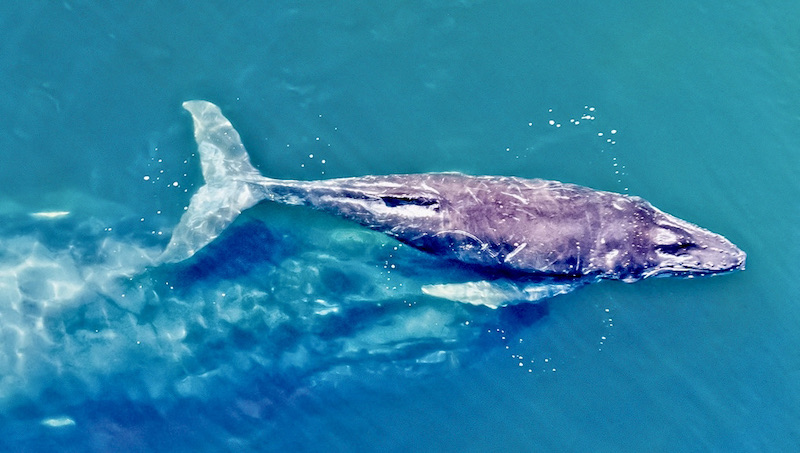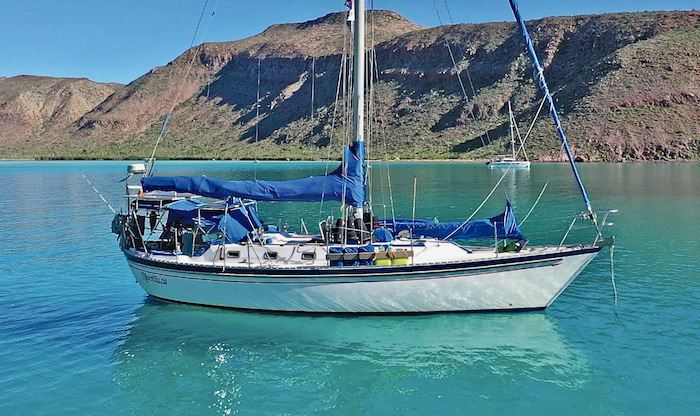
Half Moon Bay Sailors Having a Whale of a Time Aboard ‘Noctiluca’
It’s hard to believe a year has passed since we cast off from Half Moon Bay, joined the 2023 Ha-Ha, and set sail for Mexico. Time has flown by, and looking back, we’re convinced that leaving our landlubber lives behind was the right choice.
It’s been a journey with its share of challenges, but for us the rewards of living on the water far outweigh the lows. That said, our cruising kitty is looking a bit leaner than expected, thanks to some larger projects that have knocked on our hull — some of which we’re partly to blame for. Here’s what happened:
While bashing into the waves around Bahía de La Ventana, we thought our discomfort was the worst of our problems, until we caught that unmistakable whiff of diesel after anchoring near La Paz. Our starboard fuel tank decided it had had enough and sprang a leak! Fortunately, the absorbent pads in Noctiluca’s large “pre-bilge” acted as a barrier, preventing any fuel from going overboard. We quickly grabbed some portable diesel canisters in La Paz and emptied the tank completely. Now we’re left with just the port tank, which is original from 1989.
Lessons learned: Wait for a better weather window and/or avoid bashing as much as possible. There’s no shame in testing the waters and turning back if it seems as if it’s going to be too rough.
Replacing the fuel tanks is just one of the bigger projects on our growing to-do list, so we’ve decided to divide our time between cruising and work. (We’re ocean science nerds — I’m a marine biologist, and Ben works in deep-sea robotics.) We’ve continued to travel with our 70-gallon port fuel tank, plus 30 gallons of diesel from our damaged tank, now strapped down in jugs on deck.
Earlier this year, we made our way to Banderas Bay, a vibrant hub for cruisers at the entrance to the Sea of Cortez. With its reliable thermal winds, the bay is a popular gathering spot for sailors from around the world. Here, boats of all shapes and sizes rest and prepare for their next voyages. Some are racing in local regattas, while others simply enjoy the camaraderie of the cruising community. When we first arrived in early January, La Cruz de Huanacaxtle was buzzing with over 60 boats at anchor. As everyone waited for a favorable weather window, we were treated to the bay’s most spectacular visitors almost daily — humpback whales. It’s a sight that never gets old.

More than once, we’ve found ourselves unintentionally close to these gentle giants. One day, while we were out for a sail, a group of four whales headed straight toward us. We spotted their spouts just in time to adjust our course, watching in awe as they swam past, just 60 feet off our bow. Did they see us? We weren’t sure. Later, we learned from Astrid Frisch Jordan and Paulina Vidriales at ECOBAC — Ecología y Conservación de Ballenas, a local whale conservation organization in Banderas Bay — that boats without a whale-watching permit are required to stay at least 800 feet away from marine mammals for everyone’s safety. Clearly, the whales we encountered didn’t know about this rule any more than we did.
Astrid explained that humpback whales migrate to this bay every year from December to March to mate and give birth. ECOBAC keeps tabs on them, and can even identify individual whales by the shape and markings on their flukes; some have been returning to these waters since ECOBAC was founded in 1997.
In one of the most enjoyable mixes of work and pleasure I’ve ever had, they even invited me to join them on their weekly whale surveys in the bay, where we spotted over a dozen whales, many of them mothers with calves. These whales often rest close to shore in shallower waters. To answer our earlier question: Like all moms, these whales are often so focused on their own business that they don’t always notice obstacles like boats in their path — which explains our close encounter from before. We’re now much more vigilant when it comes to spotting whales, as we’ve learned that, unfortunately, collisions do happen every year. Cruisers should keep a sharp lookout for wildlife when they enter the bay. (And watch out for longlines, too — they’re a constant threat.)
We’ve enjoyed our first cruising season with great sailing, lots of wildlife viewings and fun get-togethers with other boats. As June arrived, bringing the heat and hurricane season, the bay started to quiet down. The whales moved on, and our cruiser friends and fellow Ha-Ha’ers scattered in all directions — some venturing into the Sea of Cortez, others heading south toward Panama, north to the US or Canada, or even crossing the Pacific to French Polynesia or Hawaii.
Rather than joining them, we decided to stay put in Banderas Bay for a while, first and foremost because the bay and its sailing community are simply wonderful. Plus, our seasoned lady, Noctiluca [Tayana 42], deserved some much-needed TLC, which we’re happy to provide her at Paradise Village Marina.
As mentioned, we need to replenish the cruising kitty to keep living our lives on the water. With Puerto Vallarta’s easy airport access, Ben flew back to the States to help build a deep-sea remotely operated vehicle (ROV) — under boat dog Finnegan’s watchful eyes, of course — while I helped organize an expedition aboard a research ship off the coast of Chile. Meanwhile, Noctiluca remained safely docked in Paradise Village.
Though Banderas Bay lies within the hurricane belt, it’s a relatively safe haven thanks to the surrounding mountain ranges that offer protection from the worst of the storms. Plus, the team at Paradise Village Marina has been incredible, working tirelessly to keep all the boats here secure. A special shout-out goes to Gina Markie, the marina assistant, who has been an invaluable help to us.

While waiting out hurricane season, we’ve also been busy upgrading Noctiluca with a Monitor windvane, a watermaker, and a whisker pole we bought used from fellow cruisers. These upgrades will have us well prepared for our journey south to Panama with the Ocean Posse fleet later this year or early next year — wherever the wind takes us!
Check out October’s Changes in Latitudes to see who else is cruising the seas.

I always enjoy reading about the whales. When we cruised to Mexico we had the pleasure of meeting a Momma and her baby. They never altered their course and we were with them for at least 6 hours. Mom stayed about 100 feet off of our starboard side and baby was about 50 feet off. We lost track of them after the sun went down. Later it dawned on us that Momma was probably using us to help protect her kid.